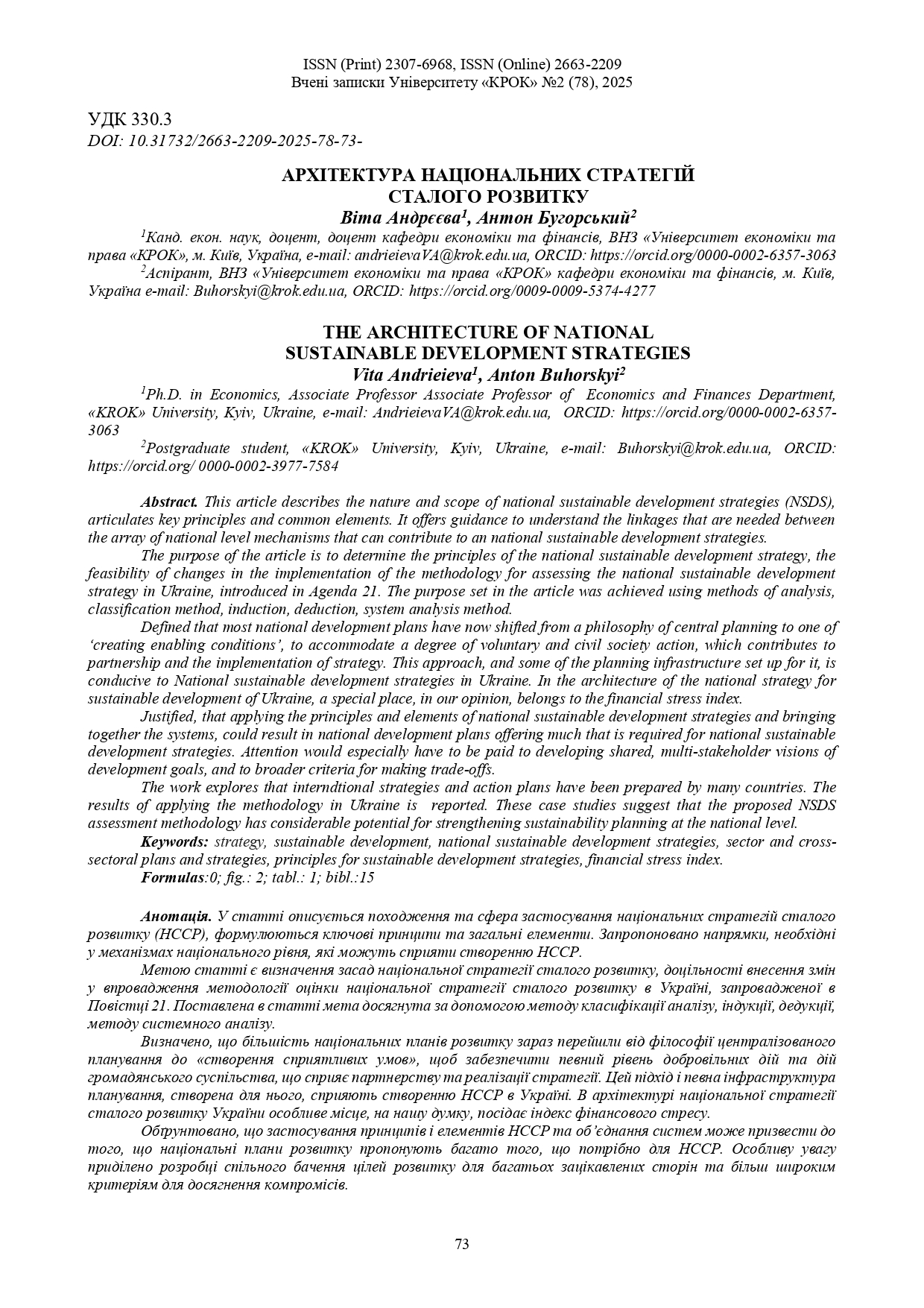THE ARCHITECTURE OF NATIONAL SUSTAINABLE DEVELOPMENT STRATEGIES
DOI:
https://doi.org/10.31732/2663-2209-2025-78-73-79Keywords:
strategy, sustainable development, national sustainable development strategies, sector and cross-sectoral plans and strategies, principles for sustainable development strategies, financial stress indexAbstract
This article describes the nature and scope of national sustainable development strategies (NSDS), articulates key principles and common elements. It offers guidance to understand the linkages that are needed between the array of national level mechanisms that can contribute to an national sustainable development strategies.
The purpose of the article is to determine the principles of the national sustainable development strategy, the feasibility of changes in the implementation of the methodology for assessing the national sustainable development strategy in Ukraine, introduced in Agenda 21. The purpose set in the article was achieved using methods of analysis, classification method, induction, deduction, system analysis method.
Defined that most national development plans have now shifted from a philosophy of central planning to one of ‘creating enabling conditions’, to accommodate a degree of voluntary and civil society action, which contributes to partnership and the implementation of strategy. This approach, and some of the planning infrastructure set up for it, is conducive to National sustainable development strategies in Ukraine. In the architecture of the national strategy for sustainable development of Ukraine, a special place, in our opinion, belongs to the financial stress index.
Justified, that applying the principles and elements of national sustainable development strategies and bringing together the systems, could result in national development plans offering much that is required for national sustainable development strategies. Attention would especially have to be paid to developing shared, multi-stakeholder visions of development goals, and to broader criteria for making trade-offs.
The work explores that interndtional strategies and action plans have been prepared by many countries. The results of applying the methodology in Ukraine is reported. These case studies suggest that the proposed NSDS assessment methodology has considerable potential for strengthening sustainability planning at the national level.
Downloads
References
Hajian, M., & Kashani, S. J. (2021). Evolution of the concept of sustainability. From Brundtland Report to sustainable development goals. In Sustainable resource management.. 1-24. Elsevier.
Prokopenko, O., Chechel A., Sotnyk, I., Omelyanenko V., Kurbatova, T. (2021). Improving state support schemes for the sustainable development of renewable energy in Ukraine. Polityka Energetyczna. 24(1). 85-100.
Skrypnyk A., Klymenko N., Tuzhyk K., Galaieva, L., Rohoza, K. (2021). Prerequisites and prospects for sustainable development of grain production in Ukraine. Agricultural and Resource Economics: International Scientific E-Journal. . 7(3). 90-106.
Kharazishvili, Y., Bugayko D., Lyashenko V., Sokolovskiy V., & Baranov, V. (2021). Strategizing for sustainable development of transport systems in the safety dimension. In IOP Conference Series: Earth and Environmental Science (Vol. 915, No. 1, p. 012025). IOP Publishing. Кузніченко Я.
Obydenkova A. (2022). Strategies and challenges of sustainable development in Eurasia. Post-Communist Economies. 34(7). 835-846.
Kaymaz Ç. K., Birinci S., & Kızılkan Y. (2022). Sustainable development goals assessment of Erzurum province with SWOT-AHP analysis. Environment, Development and Sustainability. 24(3).
Silva S. (2021). Corporate contributions to the Sustainable Development Goals: An empirical analysis informed by legitimacy theory. Journal of Cleaner Production. 292.
Kaviyarasu, M., Rashmanlou, H., Kosari, S., Broumi, S., Venitha, R., Rajeshwari, M., & Mofidnakhaei, F. (2024). Circular Economy Strategies to Promote Sustainable Development using t-Neutrosophic Fuzzy graph. Neutrosophic Sets and Systems. 72. 9.
AndrieievaV., Hryniuk N. (2023). Formation of the personnel strategy of the enterprise in conditions of marital low in Ukraine. Academic n Academic notes of KROK University. №4 (72).
Kvasha, S., Sokol, L., & Zhemoyda, O. (2017). Problems of rural sustainable development in Ukraine. Problems of Agricultural Economics. 353(4), 125-137.
Methodology for calculating the Financial Stress Index for Ukraine. (2022). National Bank of Ukraine. URL: https://bank.gov.ua/en/stability/fsi#:~:text=Calculation%20methodology%20for%20Ukraine's%20FSI,foreign%20currency%20market%20sub%2Dindex.
Kumar, S. (2022). A quest for sustain (sustainability premium): review of sustainable bonds. Academy of Accounting and Financial Studies Journal. 26(2). 1-18.
Voronina, Y., Lopushynskyi, I., Grechanyk, B., Vahonova, O., Kondur, A., & Akimov, O. (2024). Economic and environmental component in the field of sustainable development management. Calitatea. 25(201). 7-14.
Ostapenko T., Pavlov K., Pavlova O., Bortnik, S., Suriak, A., Matiichuk, L. (2024). Formation of the Baby Economy as a Prerequisite for the Development of the Human Economy and Adaptation of the National Economy of Ukraine to the Principles of Sustainable Development. Economics-innovative and economics research journal.12(2). 35-53.
Prokopenko O., Herman V., Hlivinska Y., Andrieieva V., Pikiniar V. (2025). Strategic management of the financial potential of construction enterprises: conceptual principles and practical aspects. Current issues of economic sciences, (7).

Downloads
Published
How to Cite
Issue
Section
License

This work is licensed under a Creative Commons Attribution-NonCommercial 4.0 International License.

